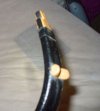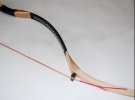So pardon my ignorance but what are the "bumpers" for on the outer limbs? Noise? Another thing im noticing is that these bows tend to have most of the flex or spring closer to the hand and the end of the limbs are built up thicker and stiffer?
Excellent observation and great question!
The bumpers are called "string bridges" that serve to change the angle of the bow string slightly, which ultimately helps increase the arrow velocity at release. I don't quite remember the explanation of how that works right now. Actually, I looked it up again. Per my friend's article from "Evolution towards the Manchu bow"
"The main difference between the Manchu bow and its predecessors is the more forward angle of the rigid ear and the presence of a prominent string bridge. This makes for a flatter force-draw curve, and more stored energy for a given poundage. Disadvantages of the design are that any bow with more forward pointing ears is also more susceptible to twist, requiring more attention and skill in maintenance. Heavy bows of this type store a lot more energy than static non-contact eared bows or contact bows with less recurve, which are the same draw weight. But they are also harder to string and require more care to maintain. Contact ears by the way weren't a new invention, they have existed since ancient antiquity. But all these ears were rather short, and the Manchu bow appears to be the first bow with very long static contact ears. The shorter ears of all previous designs somewhat reduced their maximum stored energy in comparison with the Manchu bow, but made very efficient and fast bows designed for shooting lighter arrows with high velocities much like the Korean traditional target bow."
So I maybe incorrect in saying it adds arrow speed. That is the more commonly held belief stated by "horse bow" retailers.
Though off the top of my head, the Manchu/Qing bow has the large limbs/ears by design because they wanted to shoot the largest and heaviest arrows as effectively and with as much velocity as possible.
I'll quote my friend who has done all the research into from his webpage.
http://www.manchuarchery.org/bows
"The Manchu bow is the largest of composite bows, with rigid ears not infrequently of around 30 cm in length measured from knee to tip. All composite bow ears work as levers to help bend the limbs, and due to their size this effect is most extreme among Manchu bows. This gives the design the flattest force/draw curve of traditional bows. This not only enables the bow to store more energy for a given maximum draw weight, but the flatter draw curve also reduces the need for consistent draw lengths. After all, slight fluctuations in draw length to not result in large fluctuations in arrow velocity and so if effectively solves one of the archer's main challenges: The need for very consistent draw lengths.
A well-made 60 pound Manchu bow of all traditional materials will not outperform a well-made 60 pound English longbow. The Yongzheng emperor stated that from 80 pounds and up is enough for the military, so when Wen Chieh offered to make a bow for me I ordered that poundage. It was only when we tested this bow that the facts and figures started to impress again. At 82 pounds its draw weight started to outperform the disadvantage of the weight of its ears, results were impressive. The 82# Manchu bow, made by Wen Chieh, outperformed a well-made 128# yew longbow, shooting the same 1230 grains (80g) military weight arrow a stunning 190fps against 170fps for the longbow. This is exactly the reason why the Manchu bow used to have a bad reputation: People were testing low draw-weights that were too low and found no significant advantage in poundage pulled versus arrow velocity to justify its complex construction. The design really is made for war and hunting, to do damage with heavy arrows. They may not be the fastest bow, but no other bow design can launch an arrow that heavy, that fast. There is another catch though, the high initial draw weight of Manchu bows makes them considerably harder to pull than a longbow of the same draw-weight, but at full draw they feel similar again."
To sum it up, its a purpose designed bow. Instead of showering enemies with smaller, faster arrows, they preferred to shoot bigger, relatively slower spears. And they did it well. They were still using this up to the 19th century by which pretty much everybody else had guns (they used guns too). Which makes the history of this bow so interesting, but I actually just like shooting them.
I prefer not to get into pissing matches with the other ethnic ultranationalists about who has the best bow. The best weapons are purpose designed to be the best a given task. Its pretty much like saying the AR15 is better than an M1A or vice versa without talking about which platform would best serve you in a given task.






